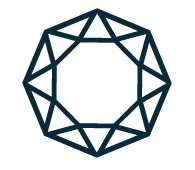In Design for Digital Fabrication, we are creating orthographic drawings of objects that already exist with Rhino ("Reverse Engineering an Object"). I chose to draw a necklace from my silver structure series. I like this for two reasons - (1) ultimately, if I wanted to mass produce this piece, creating an orthographic drawing would be one of the first steps in getting the design manufactured - and (2) having a digital version of the necklace will allow me to experiment with the individual components in so many ways - textures, color, form, etc... and start to combine the components in new ways. So, in keeping with my desire to constantly learn new - I've also begun experimenting with the necklace components in Rhino Gold. Rhino Gold is specifically made for jewelry designers and has so many really great functions for composing designs (kid in a candy store), like the chain command.
From one single component or element, you can use the chain command to essentially "array" that object on a designated curve of any shape - open or closed, however many you want, and at whatever angle you'd like. You can see above, I've used the chain command to array the orange diamond shape on the oval. I also drew a control point curve that was open at each end (right - blue & orange), which I did two separate chain commands for each separate component. The results are OK. You can see that with a component of this size, it is are to take sharp angles - but overall the rendered designs, while completely inaccurate in function - are relatively believable mock-ups that could function as quick sketches with ease.
I also experimented with the dynamic array command - which I suspect was originally designed for creating halos. This tool - while it is a little bit more finicky with the irregular shapes of my design - gave me more control over the spacing, angle relation, and scale of my components.
The dynamic array coupled with slight gumball adjustments - yielded precise interlocking results, and it only really took about an hour to figure out, once I found my rhythm. I can definitely see this coming in handy when I am in need of the perfect model. Now, I just need to figure out how to make the chain move digitally like the chain moves in real life. Small task, I'm sure.




